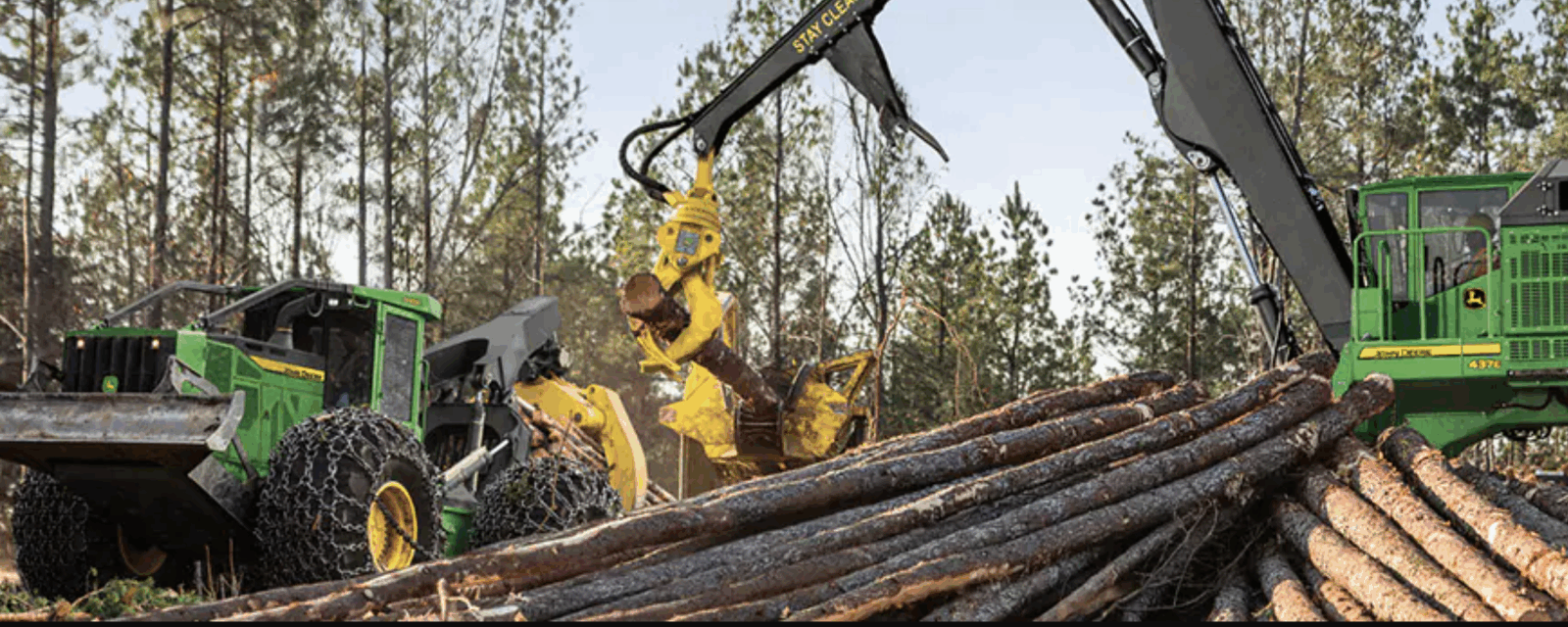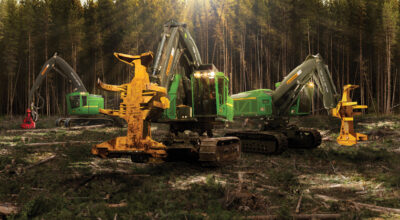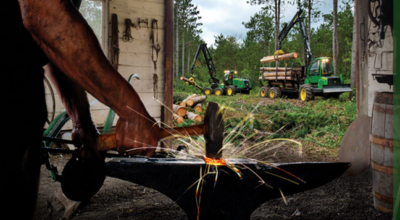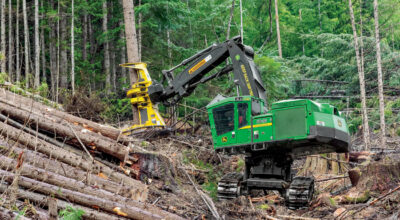Forestry and logging equipment has been used to help the process of logging, but since there are so many different types of equipment, users need to consider what actually fills the needs of their business. In this post, we explore the different types of forestry equipment, their uses and commonly asked questions.
Key Takeaways
- John Deere offers a variety of forestry equipment, including forestry skidders, feller bunchers, knuckleboom loaders, forestry swing machines, wood chippers, forestry mulchers, and more.
- Selective and clear-cutting are two main methods of logging. Selective logging is when loggers only cut wood that they know is highly valued (mahogany, oak, maple). Clear-cutting is not as selective, and therefore, loggers end up cutting down all trees in the given area, regardless of the type.
- The most common types of equipment that are used to load logs are log loaders, as well as cranes, forklifts, winch machines, and more.
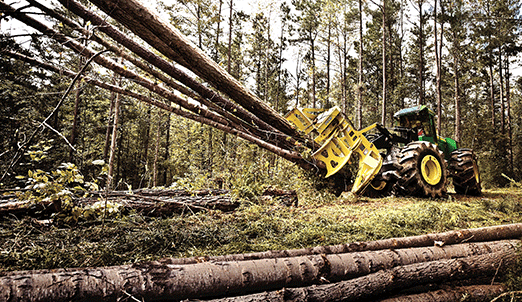
Forestry Equipment FAQs
Construction and forestry professionals rely heavily on John Deere equipment to get their jobs done. Whether it be loading logs, turning lumber into wood chips, or any other necessary job, there’s always a piece of equipment to help.
Where is John Deere Forestry Equipment Made?
While John Deere has a number of different factory locations for various kinds of equipment, a large percentage of logging and forestry equipment comes from the John Deere Dubuque Works factory, which is located in Dubuque, IA.
What Equipment is Used for Logging & Forestry?
There are quite a few styles of logging and forestry equipment used for different applications:
- Forestry Skidders: A forestry skidder drags lumber and materials out of the woods.
- Feller Bunchers: A feller buncher harvests logs by rapidly cutting and gathering several trees before felling them.
- Knuckleboom Loaders: Knuckleboom loaders are swing machines designed for handling logs with quick hydraulics for efficient swing and boom movements.
- Swing Machines: Forestry swing machines can be used in road building, shovel logging, harvesting, processing, and more.
- Wood Chippers: A wood chipper reduces or chips wood into smaller pieces.
- Forestry Mulchers: Forestry mulchers help shred vegetation with a rotary drum and steel chipper.
- Forestry Harvesters: Forestry Harvesters are heavy duty machines that help to harvest logs.
- Forestry Forwarders: Forwarders are vehicles used to carry logs after harvesting.
- Shovel Loggers: A shovel logger operates in wet terrains to recover valuable products.
- Stump Shredders: Stump shredders use a rotating cutting disk to shred tree stumps and turn them into small chips.
Logging & Timber FAQs
When thinking of John Deere, the first thing that usually comes to mind is agricultural equipment, but the company offers a massive array of forestry equipment. Let’s take a closer look at some common questions related to John Deere logging equipment.
What are Some Methods of Logging?
There are two main methods of logging, which include Selective and Clear-Cutting. The Selective logging method is when loggers only cut wood that they know is highly valued, like mahogany, oak or maple. Clear-Cutting, on the other hand, is not as selective and therefore loggers end up cutting down all trees in the given area, regardless of the type.
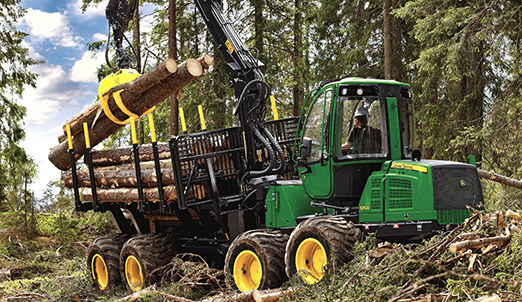
How is Timber Harvested?
- The first step to harvesting timber is to use a feller buncher. This machine will help you rapidly cut and gather trees before they need to be felled.
- Then, when you make the initial cut to the tree, you’ll want to think about where you cut and where the tree will fall.
- Next, more cuts will be needed for the tree to actually fall.
- After the tree limbs are removed, next comes the process of skidding. This is when logs are moved from the woods to a landing area.
- Logs are then loaded onto the trucks with a forwarder.
How Often Can Timber Be Harvested?
When using the selective method of tree harvesting, sustainability and ethics allow for the harvest of timber as often as every 10-15 years.
What is a Logging Machine Called?
There are many different kinds of machines that are classified as logging equipment including feller bunchers, harvesters, steer skidders, forwarders and more.
What Equipment Do You Need to Load Logs?
The most common types of equipment that are used to load logs are log loaders, as well as cranes, forklifts, winch machines and more.
What Do Loggers Do?
Loggers are known for harvesting, moving, and transporting logs while also playing an important role in extracting trees from forests for various reasons. Loggers also help manage forests by sifting through and removing unhealthy and dead trees.
Log Skidder Commonly Asked Questions
Log skidders are an important piece of equipment for loggers, as they help to pull trees from the forest. There are a lot of different aspects and uses of the log skidder which leads to a lot of questions about the machine.
What is a Log Skidder?
A log skidder is used to pull cut trees out of forests. They come in a variety of different models and sizes. They are an essential piece of equipment when it comes to forestry management.
How Do You Operate a Log Skidder?
Log skidders are typically used in forestry management in order to help the processes of managing, clearing, and removing cut trees from forests. Additionally, they can help load logs onto trucks to be transported, clear different sections of debris, move cut trees away from a harvesting area, or remove fallen trees.
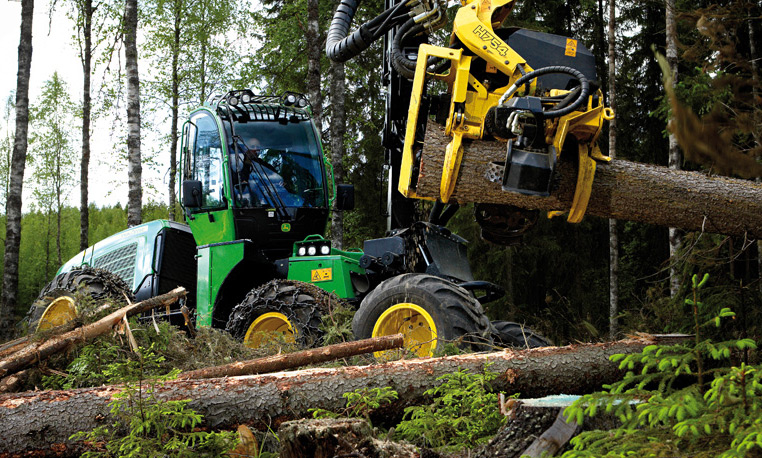
What are the Different Types of John Deere Log Skidders?
John Deere has 3 different styles of log skidders, which include:
- Cable Skidders
- Bogie Skidders
- Grapple Skidders
Each of these categories of log skidders feature multiple different models which are designed to work to scale, and be efficient for any job needed.
What is the Difference Between a Log Skidder and Dozer?
The main difference between log skidders and dozers is that log skidders are on tires, while dozers are on tracks. Additionally, log skidders are designed to drag logs behind them through terrain, whereas a dozer pushes materials out in front of it.
Feller Bunchers Commonly Asked Questions
Feller bunchers, similar to log skidders, provide a certain purpose when it comes to timber harvesting. Since it is often used in forestry, there are a lot of frequently asked questions related to the machines.
What is a Feller Buncher?
A feller buncher is a harvesting related machine that is used in logging. It’s a motorized vehicle that has an attachment which rapidly gathers and cuts trees before felling them.
What Does a Feller Buncher Do?
Feller bunchers cut down trees and group them, however these machines don’t typically possess delimbing or bucking abilities. Similar to a harvester, tracked and wheeled feller bunchers are available.
When Was the Feller Buncher Invented?
Historians give credit to Erv Drott for creating the first track-type feller buncher in the late 1960s.
Wood Chipper Commonly Asked Questions
When the weather warms up in the Spring, you might find dead or loose limbs on and around your property. When this happens, take advantage by turning those tree limbs into wood chips. Wood chips are a wonderful product for landscaping since they reduce water evaporation, which reduces the need for watering.
How Does a Wood Chipper Work?
Wood chippers utilize cutting blades in order to chip away at wood that it is fed. The blades rotate very fast, chipping the wood into much smaller pieces and then expelling it out through the other end of the machine.
What is a Wood Chipper?
A wood chipper, also known as a tree chipper is used to reduce wood into smaller pieces known as wood chips. They are oftentimes portable machines, which are mounted on wheels on frames that are suitable for towing behind a truck or van.
How Do You Use a Wood Chipper?
- Place Wood Chipper on Level Ground: Start by placing your wood chipper on level ground because you don’t want the machine to move, tilt, or fall while in use.
- Adjust the Deflector and Chute: Make sure both the deflector and chute are set to control the direction and speed in which the chips and mulch are released.
- Set the Parking Brake: Set the parking brake to ensure the piece of equipment that the wood chipper is attached to doesn’t move.
- Check Power Source: Make sure any gas-powered engine has enough fuel to complete the job, and make sure that the cord looks like it is in good condition so that dangerous situations are avoided.
- Start the Wood Chipper: Assuming you have the proper machinery in place, and all safety precautions are taken, you can then start the chipper.
- Stand to One Side: It’s important to always stand on one side rather than in front of the hopper, where you feed the material, to avoid serious injury.
- Feed Contents Into the Chipper: Lastly, feed a mixture of dry and green leaves through the wood chipper instead of separating the two by leaf and wood type. Using green leaves alongside the dead ones helps reduce the amount of work done by the chipper.
Winterizing Forestry Equipment: 10 Items to Consider
Winterizing forestry equipment is also crucial to ensuring your machines work properly all year round. Here are the 10 items to look at to winterize your forestry and logging equipment.
- Operator’s Manual: Make sure to consult your operator’s manual so you have guidelines to follow when it comes to oil, coolant and even fuel.
- Machine’s Battery: It’s important to check your vehicle’s battery on a regular basis.
- Electrical Wiring: Making sure this is intact ensures less risk of machine malfunction.
- Rubber Hoses/Parts: Since chemicals can eat away at the rubber, you’ll want to check for pinholes.
- Fuel Tank Refill: Since issues can occur in the winter, it’s a good idea to constantly make sure the fuel tank is filled on your machine.
- Grease: To avoid rust, use grease on metal parts of your machine.
- Inflate Tires: It’s crucial to the stability of your vehicle that you Inflate your tires to the recommended PSI.
- Remove Any Debris: To avoid any potential injury, remove any ice, snow or other debris before taking equipment on the road.
- Store Equipment Correctly: You will also want to store your equipment and all your attachments in an area with stable temperatures and conditions when not being used.
- Diesel Engines: Warming your diesel engines before beginning work can help you avoid leaks or gasket failures.
John Deere Forestry Equipment: How to Find the Perfect Machine For You
As we’ve seen, John Deere forestry equipment has a wide range of features. If you have any questions about John Deere logging or forestry equipment or would like to know more about how you can get your own, you can contact your local John Deere dealer.
If you enjoyed this post or want to read others, feel free to connect with us on Facebook, Pinterest, Twitter, or Instagram!
